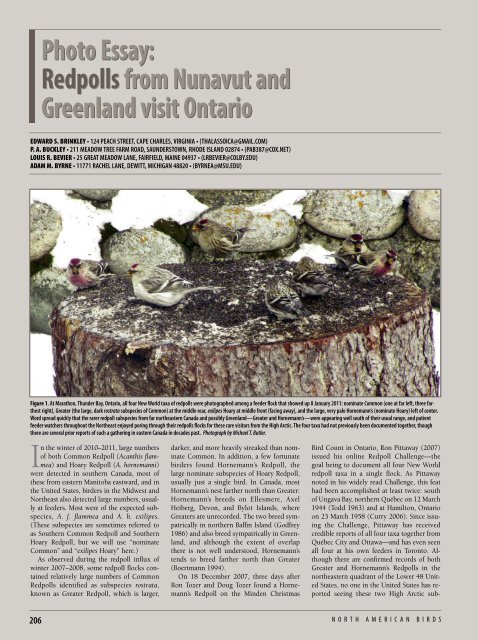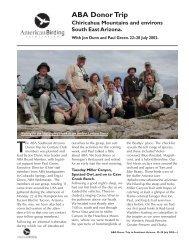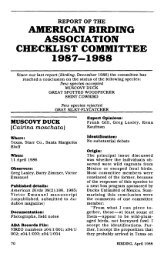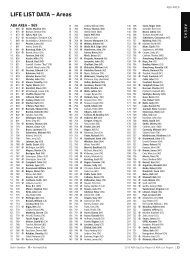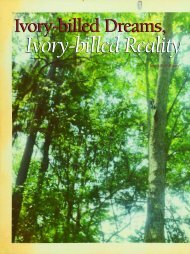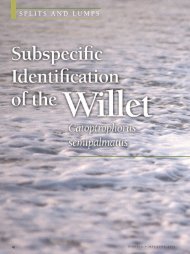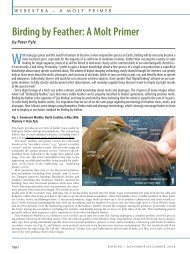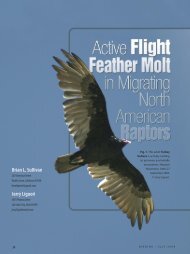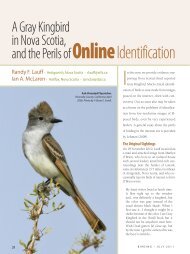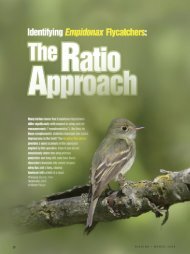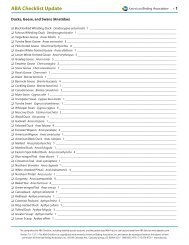Photo Essay: Redpolls from Nunavut and Greenland visit Ontario ...
Photo Essay: Redpolls from Nunavut and Greenland visit Ontario ...
Photo Essay: Redpolls from Nunavut and Greenland visit Ontario ...
- No tags were found...
Create successful ePaper yourself
Turn your PDF publications into a flip-book with our unique Google optimized e-Paper software.
<strong>Photo</strong> <strong>Essay</strong>:<strong>Redpolls</strong> <strong>from</strong> <strong>Nunavut</strong> <strong>and</strong>Greenl<strong>and</strong> <strong>visit</strong> <strong>Ontario</strong>EDWARD S. BRINKLEY • 124 PEACH STREET, CAPE CHARLES, VIRGINIA • (THALASSOICA@GMAIL.COM)P. A. BUCKLEY • 211 MEADOW TREE FARM ROAD, SAUNDERSTOWN, RHODE ISLAND 02874 • (PAB387@COX.NET)LOUIS R. BEVIER • 25 GREAT MEADOW LANE, FAIRFIELD, MAINE 04937 • (LRBEVIER@COLBY.EDU)ADAM M. BYRNE • 11771 RACHEL LANE, DEWITT, MICHIGAN 48820 • (BYRNEA@MSU.EDU)Figure 1. At Marathon, Thunder Bay, <strong>Ontario</strong>, all four New World taxa of redpolls were photographed among a feeder flock that showed up 8 January 2011: nominate Common (one at far left, three farthestright), Greater (the large, dark rostrata subspecies of Common) at the middle rear, exilipes Hoary at middle front (facing away), <strong>and</strong> the large, very pale Hornemann’s (nominate Hoary) left of center.Word spread quickly that the rarer redpoll subspecies <strong>from</strong> far northeastern Canada <strong>and</strong> possibly Greenl<strong>and</strong>—Greater <strong>and</strong> Hornemann’s—were appearing well south of their usual range, <strong>and</strong> patientfeeder watchers throughout the Northeast enjoyed poring through their redpolls flocks for these rare <strong>visit</strong>ors <strong>from</strong> the High Arctic. The four taxa had not previously been documented together, thoughthere are several prior reports of such a gathering in eastern Canada in decades past. <strong>Photo</strong>graph by Michael T. Butler.In the winter of 2010–2011, large numbersof both Common Redpoll (Acanthis flammea)<strong>and</strong> Hoary Redpoll (A. hornemanni)were detected in southern Canada, most ofthese <strong>from</strong> eastern Manitoba eastward, <strong>and</strong> inthe United States, birders in the Midwest <strong>and</strong>Northeast also detected large numbers, usuallyat feeders. Most were of the expected subspecies,A. f. flammea <strong>and</strong> A. h. exilipes.(These subspecies are sometimes referred toas Southern Common Redpoll <strong>and</strong> SouthernHoary Redpoll, but we will use “nominateCommon” <strong>and</strong> “exilipes Hoary” here.)As observed during the redpoll influx ofwinter 2007–2008, some redpoll flocks containedrelatively large numbers of Common<strong>Redpolls</strong> identified as subspecies rostrata,known as Greater Redpoll, which is larger,darker, <strong>and</strong> more heavily streaked than nominateCommon. In addition, a few fortunatebirders found Hornemann’s Redpoll, thelarge nominate subspecies of Hoary Redpoll,usually just a single bird. In Canada, mostHornemann’s nest farther north than Greater:Hornemann’s breeds on Ellesmere, AxelHeiberg, Devon, <strong>and</strong> Bylot Isl<strong>and</strong>s, whereGreaters are unrecorded. The two breed sympatricallyin northern Baffin Isl<strong>and</strong> (Godfrey1986) <strong>and</strong> also breed sympatrically in Greenl<strong>and</strong>,<strong>and</strong> although the extent of overlapthere is not well understood, Hornemann’stends to breed farther north than Greater(Boertmann 1994).On 18 December 2007, three days afterRon Tozer <strong>and</strong> Doug Tozer found a Hornemann’sRedpoll on the Minden ChristmasBird Count in <strong>Ontario</strong>, Ron Pittaway (2007)issued his online Redpoll Challenge—thegoal being to document all four New Worldredpoll taxa in a single flock. As Pittawaynoted in his widely read Challenge, this feathad been accomplished at least twice: southof Ungava Bay, northern Québec on 12 March1944 (Todd 1963) <strong>and</strong> at Hamilton, <strong>Ontario</strong>on 23 March 1958 (Curry 2006). Since issuingthe Challenge, Pittaway has receivedcredible reports of all four taxa together <strong>from</strong>Québec City <strong>and</strong> Ottawa—<strong>and</strong> has even seenall four at his own feeders in Toronto. Althoughthere are confirmed records of bothGreater <strong>and</strong> Hornemann’s <strong>Redpolls</strong> in thenortheastern quadrant of the Lower 48 UnitedStates, no one in the United States has reportedseeing these two High Arctic sub-206N O R T H A M E R I C A N B I R D S
PHOTO ESSAY: REDPOLLS FROM NUNAVUT AND GREENLAND VISIT ONTARIOspecies simultaneously among gatherings ofthe more expected nominate Common Redpoll<strong>and</strong> exilipes Hoary Redpoll.On 8 January 2011, Michael Butler, payingcareful attention to redpoll flocks in his backyardat Marathon, <strong>Ontario</strong>, on the northshore of Lake Superior, photographed aHornemann’s Redpoll. In reviewing his images,Butler noted that one bird in the backgroundappeared to be a Greater Redpoll, <strong>and</strong>another in the foreground was an exilipesHoary (Figure 1). Experts in the identificationof redpolls, Ron Pittaway <strong>and</strong> MichelGosselin, agreed: all four taxa were visible—the first time the four North American taxawere known to have been photographed together!Following Butler’s discovery, it becameclear that redpolls of all sorts had madeit to northeastern <strong>Ontario</strong> as well, <strong>and</strong> Br<strong>and</strong>onHolden made his way to Matheson on 18February 2011, to discover at least fiveHornemann’s <strong>and</strong> many Greater <strong>Redpolls</strong>among redpolls flocks at feeders. SouthernNew Engl<strong>and</strong> <strong>and</strong> upstate New York hadscattered reports of Greater <strong>and</strong> Hornemann’s<strong>Redpolls</strong>, <strong>and</strong> many birders there got to observethese big redpolls for the first time.Along with many other web-based conversations<strong>and</strong> shared images, Holden’s <strong>and</strong> Butler’swebsites, full of fine images of thesebirds, became the impetus for the present<strong>Photo</strong> <strong>Essay</strong>.In the history of North American Birds <strong>and</strong>its antecedent journals, the little-knownHornemann’s Redpoll has been mentioned infrequently,<strong>and</strong> black-<strong>and</strong>-white photographshave been published only twice, <strong>from</strong> Québec(Aubry et al. 1988) <strong>and</strong> possibly Pennsylvania(Brinkley et al. 1994). Generally acceptedrecords of Hornemann’s Redpoll extend southto Maryl<strong>and</strong> <strong>and</strong> west as far as Michigan <strong>and</strong>Manitoba, whereas records of exilipes HoaryRedpoll extend south to Virginia <strong>and</strong> muchfarther to the west, with records <strong>from</strong> SouthDakota, Nebraska, Wyoming, Idaho, Washington,<strong>and</strong> Oregon. Greater Redpoll has beendocumented in New Engl<strong>and</strong> <strong>and</strong> the northernGreat Lakes region, with outlying recordsextending to southern New York <strong>and</strong> NewJersey; there are also single records <strong>from</strong> Colorado<strong>and</strong> Maryl<strong>and</strong>. Pittaway (1992) reportsthat Greater <strong>Redpolls</strong> are more common thanHoaries during some winters in southern <strong>Ontario</strong>.The relative abundance of Greater Redpollin the northeastern United States is notas well understood.With the rise of Internet-based communication,numerous observers have posted imagesof redpolls, including Hornemann’s <strong>and</strong>Greater, <strong>from</strong> their areas, along with observationsabout redpoll identification. As oftenoccurs, many of the formerly active hyperlinkshave become inactive, <strong>and</strong> some of thediscussion that remains archived in scatteredplaces includes misleading material <strong>and</strong> errors.There are numerous published articleson redpolls <strong>and</strong> their identification, <strong>and</strong>some are readily available <strong>from</strong> their publishersor are even archived online. Some of theseare based on scientific studies, but manywere written by people who witnessed a redpollirruption in their areas. During the winterof 1993-1994, for example, Dave Czaplak(1995) studied hundreds of redpolls at hisGermantown, Maryl<strong>and</strong> feeders—<strong>and</strong> documentednot just 17 exilipes Hoary <strong>Redpolls</strong>but also at least one each of Greater <strong>and</strong>Hornemann’s. In <strong>Ontario</strong>, Pittaway (1992)summarized what was known about theidentification of North American taxa basedon his extensive encounters with redpollsduring irruptions in Canada. In the UnitedKingdom, a 1984 irruption of nominateCommon <strong>and</strong> exilipes Hoary <strong>Redpolls</strong> wasthe occasion for a paper treating differencesbetween those taxa (Lansdown et al. 1991),<strong>and</strong> other authors have followed suit aftersubsequent redpoll flights in the UnitedKingdom (Riddington et al. 2000, Pennington<strong>and</strong> Maher 2005).Using Michael Butler’s photographs <strong>from</strong><strong>Ontario</strong>’s Thunder Bay District <strong>and</strong> Br<strong>and</strong>onHolden’s images <strong>from</strong> the Cochrane District(near the Québec border), this <strong>Photo</strong> <strong>Essay</strong>showcases the High Arctic redpolls amongtheir smaller relatives <strong>and</strong> also illustratessome distinctions between Hoary <strong>and</strong> Common,whose identification continues to providechallenges. We look first at distinctionsbetween exilipes Hoary <strong>and</strong> nominate CommonRedpoll, then at differences betweenHornemann’s Redpoll <strong>and</strong> exilipes Hoary Redpoll,<strong>and</strong> lastly at differences between GreaterRedpoll <strong>and</strong> nominate Common Redpoll.Thankfully, Hornemann’s <strong>and</strong> Greater havevery dissimilar plumages, but a few of the imagesthat follow depict the two together.Redpoll identification: history<strong>and</strong> cautionary considerationsAlthough most field guides to North Americanbirds illustrate basic differences betweentypical adult Common <strong>and</strong> Hoary <strong>Redpolls</strong>fairly well, the field marks emphasized inthese guides must often be used in conjunctionwith subtler characters to make a strongcase for identifying many individuals. Redpollplumages have been critically described in theAmerican scientific literature since Coues(1861) <strong>and</strong> Ridgway (1901). Various authorshave recognized between one <strong>and</strong> six speciesof redpoll, though most recognize just two inNorth America, Hoary <strong>and</strong> Common, thesebeing distinguished chiefly by plumage featuresrather than measurements. Troy (1985)collected redpoll specimens (nominate Common<strong>and</strong> exilipes Hoary only) <strong>from</strong> Alaska tonorthern Québec <strong>and</strong> focused on streaking inundertail coverts, rump, <strong>and</strong> flanks as a wayto evaluate plumage variation in redpolls,which he treated as a single species. Thattreatment has not been followed by subsequentauthors, who treat Common <strong>and</strong> Hoaryas distinct species (Molau 1985, Knox 1988,Herremans 1990, Seutin et al. 1992, 1993,1995). Most authors indicate that differencesin streaking have some value when distinguishingthe generally less-streaked Hoary<strong>from</strong> the more-streaked Common, but all authorswho discuss field identification cautionthat some individuals may not be identifiableto species or subspecies.Knox <strong>and</strong> Lowther (2000b), for instance,indicate that nominate Common Redpoll(Figure 2) usually shows “broad streaks onundertail coverts” <strong>and</strong> a “rump normally withextensive streaks; adult male [exilipes] Hoary<strong>Redpolls</strong> have at most 1-3 hairline streaks onlongest undertail coverts.” Also in exilipes,the flanks <strong>and</strong> breast tend to show less streaking(<strong>and</strong> generally finer streaks on average)than in nominate Common, <strong>and</strong> mantlefeathers <strong>and</strong> scapulars tend to be paler, as dothe edges of upperwing coverts <strong>and</strong> secondaries.Finally, the upperparts tend toward white<strong>and</strong> gray in Hoary, toward buffy <strong>and</strong> brown inCommon, though some exilipes Hoaries havebuffy tones in the head <strong>and</strong> back (Knox <strong>and</strong>Lowther 2000b) <strong>and</strong> Hornemann’s frequentlyhave such tones (van den Berg et al. 2007).These general differences between thepalest, least streaked Hoary <strong>Redpolls</strong> <strong>and</strong> thedarkest, most heavily streaked Commons arehelpful when an observer is just gaining confidencein identifying redpolls to species. Asone begins to look carefully through largeflocks of redpolls, however, it becomes clearthat there are many birds that seem to be intermediatebetween the more stereotypicalCommon <strong>and</strong> Hoary <strong>and</strong> that differences inplumage appear to form a continuum, withsome individuals falling into a gray area notadequately treated in field guides. As Pittaway(1992, 2007) has emphasized, part ofthe reason for the extensive variation we observeis that each taxon shows plumage variationby age <strong>and</strong> sex—thus each has mini-V O L U M E 6 5 ( 2 0 1 1 ) • N U M B E R 2 207
PHOTO ESSAY: REDPOLLS FROM NUNAVUT AND GREENLAND VISIT ONTARIOFigure 2. Common <strong>Redpolls</strong> of the nominate subspecies normally make up over 99% of the redpollsobserved in feeder flocks in southern Canada <strong>and</strong> the United States. Their plumage tones are generallybrowner above than in Hoary, their streaking below more extensive <strong>and</strong> broader, especiallyalong the flanks, their cap <strong>and</strong> facial markings more extensive, <strong>and</strong> the white in their remiges <strong>and</strong>coverts less extensive. Adult males, such as these, usually show pink <strong>and</strong> rose colors in the underparts,especially pronounced <strong>from</strong> midwinter into spring, as the pale edges of these feathers wear.Adult females show limited or no rosy tones below, <strong>and</strong> first-year birds often have none. Matheson,<strong>Ontario</strong>, 18 February 2011. <strong>Photo</strong>graph by Br<strong>and</strong>on R. Holden.Figure 5. Especially when seen together, “classic” exilipes Hoary (left) <strong>and</strong> nominate Common (right)<strong>Redpolls</strong> are straightforward to identify. Hoary’s much whiter plumage, more sparsely streaked (orunstreaked) flanks, smaller bill, as well as its (sometimes) less extensive red “poll” <strong>and</strong> reduced darkplumage around the bill, make it st<strong>and</strong> out next to a darker, streakier, more colorful Common.When comparing bills of redpolls, observers should assess relative size/shape when birds are in perfectprofile (cf. Figure 7), rather than when bills are turned <strong>and</strong> thus foreshortened, as with theCommon here. The photographer notes that these redpolls were both small birds, comparable insize, thus the Hoary was certainly an exilipes rather than a nominate bird. The extent of pink on theCommon’s breast suggests a male, while the grayish head <strong>and</strong> mantle of the Hoary <strong>and</strong> its lack ofrosy tones below suggest that it is not an adult male but possibly an adult female. Matheson, <strong>Ontario</strong>,18 February 2011. <strong>Photo</strong>graph by Br<strong>and</strong>on R. Holden.Figure 3. “Dilute-plumaged” leucistic redpolls pose real problems for field identification. Commonor Hoary? The small bill <strong>and</strong> very small red “poll” might suggest the latter. Ottawa, <strong>Ontario</strong>, 19 February2011. <strong>Photo</strong>graph by Wilson Hum.Figure 4. Obviously leucistic redpolls with patchy, “piebald” plumages can sometimes be identifiedto species by looking carefully at the parts of plumage that are normally pigmented or by comparingthe bird’s bill to adjacent redpolls. However, some individuals, such as this one at Cobourg, <strong>Ontario</strong>on 6 March 2011, may be best left unidentified. <strong>Photo</strong>graph by Harvey Gold.Figure 6. This adult exilipes Hoary Redpoll shows the extensive feathering covering the bill that is often,but not always, seen in Hoaries. The rich rosy cap <strong>and</strong> pink tones in the breast suggest an adultmale, some of which show very little pink below, especially early in the winter, when the plumage isstill relatively fresh. Marathon, <strong>Ontario</strong>, 28 January 2011. <strong>Photo</strong>graph by Michael T. Butler.208N O R T H A M E R I C A N B I R D S
PHOTO ESSAY: REDPOLLS FROM NUNAVUT AND GREENLAND VISIT ONTARIOmally four plumages that may be present in a flock. As with one’s firstencounters with mixed-species flocks of rosy-finches (Leucostictespp.), sorting through the different plumages can be daunting. Articleson redpoll identification that use photographs of specimens<strong>and</strong>/or captured birds often show disheveled plumages or birds in oddposes, which can obscure some distinctions. Studying birds in life hasits challenges but is a requisite for underst<strong>and</strong>ing redpoll plumages<strong>and</strong> structures.Probably because Hoary Redpoll has been considered very rare inmost areas, observers have often assumed that birds that appeared “intermediate”between the field guide illustrations were paler-than-averageCommon <strong>Redpolls</strong>. In some cases, that may be accurate. In fieldidentification, birders frequently opt for the species presumed to bemost likely; one could say that birders often apply Occam’s razor, thelaw of parsimony, when faced with possible new hypotheses. Over thepast several decades, however, assumptions about the status, distribution,<strong>and</strong> identification of Hoary Redpoll have given way to the realizationthat even some southerly redpolls flocks (e.g., Czaplak 1995)may contain multiple Hoary <strong>Redpolls</strong>—<strong>and</strong> that few if any of thesewill be adult males. Echoing the findings of Knox (1988), Kaufman(1994) summarized the problem facing birders: “It may be that ourimage of the ‘typical’ Hoary is really based on extreme individuals.This conservative approach to identifying this species is commendablebut may skew our perception of its actual numbers, with only thepalest individuals being detected most of the time.” One might modifythat sentiment: with only the palest individuals being readily acceptedby the birding community <strong>and</strong> records committees. We may rightlysuspect that at least some birds identified in the past as “pale Commons”were instead first-year exilipes Hoary <strong>Redpolls</strong>. Of course,Common <strong>Redpolls</strong> also show variation, no less important to study <strong>and</strong>consider than variation in exilipes Hoary <strong>and</strong> other taxa.Birds of intermediate appearance have also sometimes been presumedto be hybrids. As yet, no documentation exists of either a mixed redpollpair or a hybrid in North America, <strong>and</strong> field studies suggest that nominateCommon <strong>and</strong> exilipes Hoary behave as separate species (see Molau1985, Knox 1988, Seutin et al. 1992, 1993, 1995). Detailed studies overlarge parts of these birds’ breeding ranges are lacking, however, <strong>and</strong>many questions remain unanswered; hybridization is certainly possible.Although studies have thus far detected low genetic distinctiveness betweenthe redpoll taxa (Seutin et al. 1995, Marthinsen et al. 2008), authorsof the latter study acknowledged that genetic differentiation couldbe too recent <strong>and</strong>/or rapid to be detected with the genetic markers theyinvestigated. Indeed, a recent study of the diverse Darwin’s finches detectedsurprisingly high genetic homogeneity (Freel<strong>and</strong> <strong>and</strong> Boag 1999).It is certainly possible that some birds considered “intermediates” or hybridsin the past (e.g., Wetherbee 1937) were so classed because redpolls’plumage variations by sex, age, <strong>and</strong> degree of wear were under-appreciated,as some authors have maintained (Molau 1985, Knox 1988;see Coues 1861). Birds with aberrant plumages may also pose problems.Leucistic Common <strong>Redpolls</strong> have been photographed, for instance,though such birds have shown blotchy patterns of white, rather than beinguniformly paler in plumage; nevertheless, a “dilute-plumaged” CommonRedpoll could surely be mistaken for a Hoary (Figures 3, 4). As istrue of a great many congeners, some redpolls of intermediate appearanceare best left unidentified: to record a “redpoll sp.” is to acknowledgehonestly a limit of field identification. Taking notes on such birds,photographing them, <strong>and</strong> discussing them with others is a superb wayto move the conversation forward on redpoll identification.Continued on page 212Figure 7. Distinguishing Common <strong>and</strong> Hoary <strong>Redpolls</strong> becomes most difficult when dealing with theleast-differentiated plumages, namely those of females <strong>and</strong> young birds. The larger bill, heavy brownishflank streaking, <strong>and</strong> generally brownish tones of the bird on the left indicate a Common Redpoll,<strong>and</strong> the lack of color in the breast suggests that it is not an adult male—more likely an adult femaleor a first-year bird. On the right, the tiny bill, unstreaked undertail coverts, small red “poll,” <strong>and</strong> overallfrostier tones point toward an exilipes Hoary Redpoll, but again, not an adult male, more likely a firstyearbird. In the wing, the Hoary shows more extensive white edges to remiges <strong>and</strong> coverts than theCommon. Matheson, <strong>Ontario</strong>, 18 February 2011. <strong>Photo</strong>graph by Br<strong>and</strong>on R. Holden.Figure 8. This rather streaky exilipes Hoary Redpoll, a first-year bird, shows a very limited area ofwhite in the rump, similar to many Commons. The buff tones in the cheek are more often seen infirst-year Hoaries, but some adults also have buff in the face (Lansdown et al. 1991). This bird’s verysmall bill <strong>and</strong> whitish ground color permit identification as exilipes Hoary. Once thought to be the“gold st<strong>and</strong>ard” for redpoll identification, rump color/pattern in young redpolls, <strong>and</strong> even adults,can be useful for identification, but extensive variation in both species limits its value. According toPyle (1997), the tapered rather than truncate tips of the outer three rectrices indicate a first-year(HY/SY) individual here. Matheson, <strong>Ontario</strong>, 18 February 2011. <strong>Photo</strong>graph by Br<strong>and</strong>on R. Holden.V O L U M E 6 5 ( 2 0 1 1 ) • N U M B E R 2 209
PHOTO ESSAY: REDPOLLS FROM NUNAVUT AND GREENLAND VISIT ONTARIOFigure 9. Differences in the pattern <strong>and</strong> colors of the upperparts, especially the rump, can be usefulfor distinguishing between Common <strong>and</strong> Hoary <strong>Redpolls</strong>. The “rump” is the area between the “back”(mantle) <strong>and</strong> the uppertail coverts (which here show dark centers). In this bird, the rump is mostlywhitish with a touch of pink, the tones of the upperparts are pale, <strong>and</strong> streaking in the underpartsappears to be minimal—all suggestions that this is a Hoary, though a few adult male Common<strong>Redpolls</strong> could perhaps approach this appearance. The very broad white edges on tertials <strong>and</strong>greater coverts, however, point to Hoary. Lansdown et al. (1991) suggest that Hoary may droop thewings more regularly than Common, but no evidence supports this suggestion. Marathon, <strong>Ontario</strong>,18 January 2011. <strong>Photo</strong>graph by Michael T. Butler.Figure 12. This exilipes Hoary Redpoll (left), probably a first-year bird (note tapered tips of outerrectrices), shows some brownish tones in face <strong>and</strong> back, but overall its tones are quite gray <strong>and</strong>whitish; note also the very limited amount of red in the crown, very small bill, <strong>and</strong> the limited areaof dark plumage around the bill, all more typical of Hoary. Having a nominate Common Redpoll inthe same frame makes assessment of plumage tones <strong>and</strong> bill structure much easier with a nonadultHoary. Matheson, <strong>Ontario</strong>, 18 February 2011. <strong>Photo</strong>graph by Br<strong>and</strong>on R. Holden.Figure 10. This exilipes Hoary Redpoll shows extensive white in the rump, thin streaking restricted mostlyto the flanks, <strong>and</strong> unstreaked undertail coverts (not entirely in view here). The relatively large redforecrown patch, as well as the medium-sized bill, might suggest a pale Common Redpoll, but both featuresvary in both species. The brownish tones in the back <strong>and</strong> buff tones in the face suggest that thisbird may not be an adult, but the well-developed white edges in the wings <strong>and</strong> tail <strong>and</strong> rather strong facialpattern <strong>and</strong> red crown could well indicate an adult female. When Hoary <strong>Redpolls</strong> sleek down theirplumages, they appear a bit darker than when they fluff up the plumage; this individual looks paler inother photographs. Matheson, <strong>Ontario</strong>, 18 February 2011. <strong>Photo</strong>graph by Br<strong>and</strong>on R. Holden.Figure 13. An adult, probably male Hornemann’s Redpoll, here showing the almost complete lack ofstreaking below <strong>and</strong> the stunning whiteness of plumage, including the edges of greater coverts,secondaries, <strong>and</strong> tertials. Matheson, <strong>Ontario</strong>, 18 February 2011. <strong>Photo</strong>graph by Br<strong>and</strong>on R. Holden.Figure 11. This typical adult male exilipes Hoary Redpoll is very pale overall <strong>and</strong> very lightly streakedbelow, with faint pink tones in the breast. The rosy crown patch is larger than in some adult male exilipesbut not unusually so. Marathon, <strong>Ontario</strong>, 15 January 2011. <strong>Photo</strong>graph by Michael T. Butler.Figure 14. This apparent adult Hornemann’s Redpoll shows a blush of pink not just in the breast butalso in the malar area, the rump, <strong>and</strong> the outer rectrices. The identification as Hornemann’s wasmade when it was near nominate Common <strong>Redpolls</strong>. Matheson, <strong>Ontario</strong>, 18 February 2011. <strong>Photo</strong>graphby Br<strong>and</strong>on R. Holden.210N O R T H A M E R I C A N B I R D S
PHOTO ESSAY: REDPOLLS FROM NUNAVUT AND GREENLAND VISIT ONTARIOFigure 15. When a redpoll looks like a snowball, it’s worth a photograph. Although this bird nearMarathon, <strong>Ontario</strong> has fluffed its plumage <strong>and</strong> raised its wings, exaggerating the rotundity of itsappearance, its overall whiteness <strong>and</strong> limited streaking certainly indicate an adult male Hoary.However, its size, when observed a few moments later among nominate Common <strong>Redpolls</strong>, wassimilar to its flockmates, which suggests an adult male exilipes Hoary rather than Hornemann’s.Judging size of redpolls is extremely difficult without the context of other individuals, ideally ofother taxa! Marathon, <strong>Ontario</strong>, 6 January 2011. <strong>Photo</strong>graph by Michael T. Butler.Figure 18. First-year Hornemann’s <strong>Redpolls</strong> show more streaking below, lack pink tones in the breast,<strong>and</strong> are less strikingly white overall than adults, but they still almost always appear much larger thanthe smaller taxa (here with a nominate Common, most likely an adult male), especially when seen inclose proximity. Matheson, <strong>Ontario</strong>, 18 February 2011. <strong>Photo</strong>graph by Br<strong>and</strong>on R. Holden.Figure 16. This exilipes Hoary Redpoll, probably an adult, possibly female, shows the featheringaround the tibia, the “pantaloons,” often seen in this species. Marathon, <strong>Ontario</strong>, 11 January 2011.<strong>Photo</strong>graph by Michael T. Butler.Figure 19. With the extensive buff in mantle, head, <strong>and</strong> upper breast, this Hornemann’s Redpollmay be a first-year bird. Note the extensive white edges of tertials <strong>and</strong> greater coverts <strong>and</strong> verylarge snow-white rump. Marathon, <strong>Ontario</strong>, 27 January 2011. <strong>Photo</strong>graph by Michael T. Butler.Figure 17. A Hornemann’s Redpoll, possibly an adult female, with a nominate Common Redpoll. Onpaper, differences in length of 10-14% may seem slight, but Hornemann’s also average significantlyheavier than both nominate Common <strong>and</strong> exilipes Hoary. Matheson, <strong>Ontario</strong>, 18 February 2011.<strong>Photo</strong>graph by Br<strong>and</strong>on R. Holden.Figure 20. Readily identifiable by plumage as a Hoary <strong>and</strong> by size as a Hornemann’s (a Greater Redpollbehind it was judged to be of similar size), this bird appears less whitish in tone <strong>and</strong> has morestreaking below than an adult male. It is probably a first-year bird or possibly an adult female.Marathon, <strong>Ontario</strong>, 6 January 2011. <strong>Photo</strong>graph by Michael T. Butler.V O L U M E 6 5 ( 2 0 1 1 ) • N U M B E R 2 211
PHOTO ESSAY: REDPOLLS FROM NUNAVUT AND GREENLAND VISIT ONTARIOFigure 21. Hornemann’s Redpoll, perhaps a first-year male. The rich buff tones of the face (called a“chamois-leather” color by van den Berg et al. [2007]) are probably more typical of younger Hornemann’sthan of adults, as is true in the better-known exilipes Hoary. Matheson, <strong>Ontario</strong>, 18 February2011. <strong>Photo</strong>graph by Br<strong>and</strong>on R. Holden.Figure 22. Two Hornemann’s <strong>Redpolls</strong> share a tree with an exilipes Hoary Redpoll (lower right), amuch smaller bird when seen in direct comparison with Hornemann’s. Observers should study <strong>and</strong>photograph groups of redpolls over long periods of time when making comparisons, as the birds’apparent shape <strong>and</strong> paleness change regularly as they fluff up the plumage against the cold. Matheson,<strong>Ontario</strong>, 18 February 2011. <strong>Photo</strong>graph by Br<strong>and</strong>on R. Holden.Figure 23. In addition to its greater length <strong>and</strong> weight, Greater Redpoll is darker than nominateCommon in all plumages, with broad, dark-brown streaking on the sides <strong>and</strong> flanks especially pronouncedbut also typically with more brown in the cheek <strong>and</strong> back overall. Matheson, <strong>Ontario</strong>, 18February 2011. <strong>Photo</strong>graph by Br<strong>and</strong>on R. Holden.Continued <strong>from</strong> page 209<strong>Redpolls</strong>, like young jaegers, show enough variation in plumagethat no single feature or even small set of features has been consideredreliable for producing an accurate identification in the field. Instead,it is necessary to evaluate all aspects of plumage, <strong>and</strong> structure, tobuild a case for identification, at least for the more challenging individuals.Many of the features associated with one species or the otherrequire qualification, <strong>and</strong> indeed even some of the more reliable featuresthat permit many individuals to be identified to species shouldnot be applied in an absolute sense. Beginning students of redpollidentification will profit <strong>from</strong> prolonged field study <strong>and</strong> <strong>from</strong> extensivephotographic documentation of the birds they observe. Plumagetones <strong>and</strong> contrasts can appear to vary because of lighting (<strong>and</strong> photographicexposure <strong>and</strong> manipulation), <strong>and</strong> in redpolls they also varywith sex <strong>and</strong> age, with adults being generally paler <strong>and</strong> more colorfulthan first-year birds <strong>and</strong> males likewise being paler overall <strong>and</strong> alsomore colorful (in crown, rump, <strong>and</strong> breast, where plumage shows redor pink) than females. Variation by age <strong>and</strong> sex has yet to be the subjectof a large scientific study in North America, though for nominateCommon Redpoll, for instance, we do know <strong>from</strong> field studies thatadult males show the most rosy red or pink in the breast (Figure 2),that first-winter males tend to be darker than adult males <strong>and</strong> oftenshow just a wash of pink, that adult females may show just a blush ofpink but usually lack it, <strong>and</strong> that first-year females tend to be darkeroverall than other plumages, with more streaking <strong>and</strong> no pink in thebreast. The red/pink breast color in nominate Common Redpoll intensifiestoward spring, as the pale tips of breast feathers wear (Lansdownet al. 1991). Other redpoll taxa show similar age- <strong>and</strong> sex-relateddistinctions between plumages, but many of the age/sex labels appliedto redpolls in the field must be considered educated guesswork,especially when birds are not examined in the h<strong>and</strong>.Even structural differences used to identify redpolls, such as thesupposedly smaller, “pushed-in” (more obtuse) appearance of exilipesHoary’s bill, should be applied with caution: studies have found minimalor no difference in the length of the bill between these species inNorth America (Knox <strong>and</strong> Lowther 2000b). A redpoll that turns itshead even slightly out of perfect profile may appear to have a stubbierbill than it actually does (Figure 5); some Common <strong>Redpolls</strong> havebills that appear small, <strong>and</strong> some exilipes Hoaries’ bills do not exhibita “pushed-in” appearance (Lansdown et al. 1991)—<strong>and</strong> Hornemann’sRedpoll has a comparatively larger bill (van den Berg et al. 2007). Redpollobservers have noted that the smaller-billed look of exilipes Hoaryresults in part <strong>from</strong> having more extensive plumage covering the baseof the bill, but this aspect is also variable (Figure 6). <strong>Redpolls</strong> of allspecies often fluff up their plumage against cold conditions, <strong>and</strong> in theprocess, their plumage may appear suddenly paler or whiter, as darkcenteredfeathers become concealed beneath the lighter plumage. Aredpoll’s overall body shape, head shape, <strong>and</strong> relative size may also appearto change, depending on the bird’s activity. To gauge relative proportions<strong>and</strong> size with accuracy, it may be necessary to study <strong>and</strong> photographindividuals over many minutes, which is not always easy withflighty, fidgety flocks. Generally, Hoary’s very dense plumage gives it abulkier appearance in body, head, <strong>and</strong> neck than Common, <strong>and</strong> this,along with exilipes Hoary’s paler plumage, is normally how birders beginthe process of separating these species in a mixed flock (Figure 5).In areas where most birders encounter them in winter, redpoll flocksare usually predominantly composed of nominate Commons, with afew exilipes Hoaries mixed in on occasion, though winter 2010–2011saw more reports of Hoaries than usual in many areas.212N O R T H A M E R I C A N B I R D S
PHOTO ESSAY: REDPOLLS FROM NUNAVUT AND GREENLAND VISIT ONTARIODistinguishing exilipes Hoary <strong>from</strong> nominate CommonAll of the distinctions illustrated in the field guides will help birderscorrectly identify a classic Common or Hoary Redpoll, <strong>and</strong> a carefulbirder would be unlikely to mistake a typical dark Common Redpollfor an adult Hoary. But there are many exceptions to the familiar fieldmarks. A few Commons, almost certainly males, show minimallystreaked undertail coverts <strong>and</strong> flanks, remarkably white rumps, <strong>and</strong> littlepink in the breast (especially in fresh plumage in autumn <strong>and</strong> earlywinter), thus closer to a Hoary. Likewise, a first-winter female Hoaryis generally the darkest of the post-juvenal plumages in that species,thus approaching female Common Redpoll in general appearance (Figures7, 8). (Note: the feathers referred to as the “rump” here are thosebetween the mantle <strong>and</strong> the uppertail coverts; Figure 9.)With birds away <strong>from</strong> the obvious extremes of typical Common orHoary, it is necessary to consider not just the well-known distinguishingfeatures but also the “soft” distinctions. Some exilipes Hoary <strong>Redpolls</strong>,for instance, show a markedly smaller red forecrown patch thana typical Common (Lansdown et al. 1991; Figures 5, 7). Most alsoshow less extensive black in the chin <strong>and</strong> lores than Commons of thesame age/sex, <strong>and</strong> this area of darker plumage in Hoary often looksmore gray or brownish gray than truly black (Knox <strong>and</strong> Lowther2000b; Figure 5-8, 10-12). Also, compared to nominate Common Redpoll,corresponding plumages of exilipes Hoary show much less pinkon the breast, with adult males often showing very little (Knox <strong>and</strong>Lowther 2000b; Figure 12). The quality of the pink is also typicallymuch less intense than in Common <strong>Redpolls</strong>, though there is muchvariation in this feature in Common (Lansdown et al. 1991). (Lightingconditions can either diminish or exaggerate this tone.) Some redpollobservers indicate that Hoary also shows not just more featheringaround the bill, on average, than Common but also more featheringaround the legs (Figures 6, 16). These features can be difficult to study,evaluate, <strong>and</strong> document. Description of most of them is subjective bynature—<strong>and</strong> some have in fact been called “useless” for distinguishingthese taxa. But they may be supportive of a case for identification thatis built primarily on other aspects of plumage.Distinguishing Hornemann’s <strong>from</strong> exilipes HoaryIts remote haunts <strong>and</strong> snow-white plumage made Hornemann’s Redpoll(Figures 13-14, 17-22) a subject of fascination for early NorthAmerican ornithologists. More recently, birders have attempted to familiarizethemselves with this taxon through the “Life Histories ofNorth American Birds” series edited by Arthur C. Bent, which containsextensive descriptions of both Hoary Redpoll subspecies (Austin1968, Baldwin 1968), <strong>and</strong> through illustrations in a few field guides(National Geographic Society 1983; Sibley 2000). But this taxon receivesrather thin treatment in most twentieth-century articles onHoary Redpoll identification (Lansdown et al. 1991, Jännes 1995,Votier et al. 2000) <strong>and</strong> in the Hoary Redpoll accounts in more recentspecialty guides (e.g., Beadle <strong>and</strong> Rising 2006). In fact, there havebeen very few convincing images of Hornemann’s published in NorthAmerica, <strong>and</strong> only a h<strong>and</strong>ful of birders know it well in life. Yves Aubry,Michel Gosselin, <strong>and</strong> Richard Yank (1987) wrote of Hornemann’s: “ahuge <strong>and</strong> distinctive white bird,” “a great rarity south of the tundra atany season.”Averaging 14.0 cm in length, Hornemann’s is the largest of all redpolltaxa, about 11% longer than most exilipes (averaging 12.5 cm)<strong>and</strong> slightly larger than Greater Redpoll (Knox <strong>and</strong> Lowther 2000b).Such size differences may seem slight, but they are sometimes apparentin the field when birds of different taxa are seen together (FiguresFigure 24. Seen face-on, Greater Redpoll’s more extensive black plumage around the bill gives it amore masked appearance than nominate Common, in some birds appearing almost ghoulish.Marathon, <strong>Ontario</strong>, 14 January 2011. <strong>Photo</strong>graph by Michael T. Butler.Figure 25. A Greater Redpoll <strong>and</strong> a Hornemann’s Redpoll take flight. Note the Greater’s dark featheringaround the tibia <strong>and</strong> very limited pale plumage in the rump. The breeding <strong>and</strong> winteringranges of these taxa overlap extensively, but their breeding biology has been little studied in recenttimes. Matheson, <strong>Ontario</strong>, 18 February 2011. <strong>Photo</strong>graph by Br<strong>and</strong>on R. Holden.Figure 26. When comparing sizes of redpolls, it is best to have them in the same plane <strong>and</strong> posture.The bird at right is likely a Greater Redpoll because it is so much larger than the accompanying exilipesHoary, but its plumage is very similar to nominate Common Redpoll. Matheson, <strong>Ontario</strong>, 18February 2011. <strong>Photo</strong>graph by Br<strong>and</strong>on R. Holden.V O L U M E 6 5 ( 2 0 1 1 ) • N U M B E R 2 213
PHOTO ESSAY: REDPOLLS FROM NUNAVUT AND GREENLAND VISIT ONTARIOFigure 27. An adult male Hornemann’s Redpoll (left), showing almost no streakingin the underparts, above a Greater Redpoll. This juxtaposition of the palest<strong>and</strong> darkest American redpoll taxa is seldom observed away <strong>and</strong> eastern <strong>Nunavut</strong><strong>and</strong> Greenl<strong>and</strong>. This adult male Hornemann’s Redpoll stayed well away <strong>from</strong> theflocking redpolls at the feeding station. Matheson, <strong>Ontario</strong>, 18 February 2011.<strong>Photo</strong>graph by Br<strong>and</strong>on R. Holden.15, 17, 18, 20)—<strong>and</strong> they are especially usefulwhen one is studying a plumage otherthan adult male (Figures 18, 19, 21). Hornemann’sexaggerates the features most associatedwith exilipes when compared to Common,appearing even whiter overall thanmost exilipes (in all parts of the plumage),with even bulkier body, longer wings <strong>and</strong> tail,thicker neck, <strong>and</strong> extensive featheringaround the tibia that look like wispy “pantaloons”—aphrase coined by Adirondackb<strong>and</strong>er John M. C. Peterson during what waslikely the largest irruption of Hoaries everrecorded in the eastern United States (Buckley<strong>and</strong> Kane 1974). Adult males have lesspink than exilipes, some showing only a traceof suffused pink on the breast, but some alsoshow pink in the rump (Knox <strong>and</strong> Lowther2000b; Figure 12). Adult females <strong>and</strong> firstyearbirds are not as blindingly white as adultmales but are often recognizable by their sizewhen compared directly to the smaller taxaflammea <strong>and</strong> exilipes (Figure 17, 18). Theseplumages appear to show more buffy tones inthe head, breast, <strong>and</strong> mantle <strong>and</strong> no pinkwhatsoever (Herremans 1991; van den Berget al. 2007).The American Ornithologists’ Union’sCheck-list Committee (A.O.U. 1998) suggeststhat the two taxa of pale redpolls “mayrepresent separate species, C. exilipes (Coues1861) [Hoary Redpoll] <strong>and</strong> C. hornemanni[Hornemann’s Redpoll].” In North America,the attractive Hornemann’s has been detectedas far <strong>from</strong> typical range as Fairbanks, Alaska(A.O.U. 1998). The mainl<strong>and</strong> of Europe hasrecords of Hornemann’s <strong>from</strong> near Abbeville,France (Degl<strong>and</strong> <strong>and</strong> Gerbe1867), at Bauvin, Pas-de Calais,France 1 February 1966 (Duboiset al. 2009), <strong>and</strong> on Ushant Isl<strong>and</strong>,France 19-21 October 1986(Dubois et al. 2008), as well as<strong>from</strong> Germany <strong>and</strong> Belgium(Hüppop 1996; Herremans1991), <strong>and</strong> a recent vagrantHornemann’s in Holl<strong>and</strong> was theoccasion for a paper that advocatedrestoring Hornemann’s to fullspeciesstatus (van den Berg et al.2007). It is certainly worth keepingHornemann’s in mind whenwatching redpolls anywhere.Distinguishing Greater Redpoll<strong>from</strong> nominate Common RedpollMuch as Hornemann’s Redpollcan be considered a larger, whiter,<strong>and</strong> less-streaked version of exilipesHoary, so Greater Redpoll resembles adarker, larger version of nominate Common,averaging about 10% longer <strong>and</strong> at least 25%heavier (Knox <strong>and</strong> Lowther 2000a). Whenobserved in direct comparison with nominateCommon—<strong>and</strong> even when observed alone—Greater has a distinctly different shape, witha heavier body (especially neck <strong>and</strong> breast),heavier bill, <strong>and</strong> longer tail (Beadle <strong>and</strong> Henshaw1996) (Figure 23). Many Greaters alsoseem to have a more bulbous culmen thannominate Commons (Beadle <strong>and</strong> Rising2006). Greater’s plumage tones are also darker,with reduced pale feather edgings in comparisonto nominate Common. The streakingof the underparts (breast, sides, <strong>and</strong> undertailcoverts) is heavier <strong>and</strong> darker in Greater thanCommon, the black adjacent the bill (chin,lores) is more extensive (Figure 24), <strong>and</strong> thenape <strong>and</strong> auriculars are also darker overall.The dark streaking below is so extensive thatit dominates the underparts, with manystreaks both thick <strong>and</strong> long/continuous (Figure25). The intensely rosy red tones of someadult male nominate Commons are almostnever matched by adult male Greaters, <strong>and</strong>Beadle <strong>and</strong> Rising (2006) indicate that maleGreaters show no red in the malar area,which male nominate Commons sometimesdo show. The more lightly marked Greaters(Figure 26), probably first-year birds, may bebest distinguished by their larger size—<strong>and</strong>often by their shape, both huskier in thechest <strong>and</strong> longer in the body/tail. Some observersassert that Greaters resting in trees appearto perch more upright than nominateCommons, <strong>and</strong> this tendency, combined withtheir larger size, darker plumage, <strong>and</strong> heavierbill, has led some observers to liken theirshape to that of House Finch (Carpodacusmexicanus).Closing thoughtsWhen studying redpolls, observers shouldalso be alert for subtle differences in behavior<strong>and</strong> should try to record vocalizations ofindividual birds that appear different. Someobservers who have spent a lot of timewatching mixed redpoll flocks have indicatedthat they can sometimes pick out an adultmale Hoary Redpoll in flight, though identificationshould be verified by plumage features.Many observers have described subtlebut distinctive differences in calls betweenHoary <strong>and</strong> Common, which agrees with thelimited literature on the subject (Knox 1988,Herremans 1989, Lansdown et al. 1991). Sostrikingly large <strong>and</strong> white were the Hornemann’sin mixed redpoll flocks in February2011 (Figure 27) that Br<strong>and</strong>on Holdencalled them the “abominable snow monsters.”Greaters may also be first detected byvocalizations; according to some, their callsgenerally sound harsher than those of nominateCommons.Observers in eastern Canada might alsowant to be on the lookout for the rather small,streaky Lesser Redpoll (A. cabaret) of Europe,a specimen of which was taken in easternGreenl<strong>and</strong> at Kuummiit on 6 September 1933(Boertmann 1994). And even closer to NorthAmerica, Common <strong>Redpolls</strong> that nest in Icel<strong>and</strong>,subspecies isl<strong>and</strong>ica, can be quite variable,with many appearing intermediate betweennominate Common <strong>and</strong> Greater, butsome birds being quite pale, very similar to exilipesor to the palest nominate Commons(Knox 1988, Lansdown et al. 1991, Pennington<strong>and</strong> Maher 2005). So how would one ruleout an Icel<strong>and</strong>ic Redpoll in the case of an “intermediate”-lookingbird in northeasternCanada, for instance? We do not know.There is surely much more to discover inour own backyards.AcknowledgmentsWe thank Ron Pittaway, Michael Butler, <strong>and</strong>Br<strong>and</strong>on Holden for their thorough, engagingeditings of early drafts of this <strong>Photo</strong> <strong>Essay</strong>.Arnoud van den Berg <strong>and</strong> Georges Oliosokindly helped with literature <strong>from</strong> Europe,<strong>and</strong> both have our gratitude.Literature citedAmerican Ornithologists’ Union [A.O.U.].1998. American Ornithologists’ Union214N O R T H A M E R I C A N B I R D S
PHOTO ESSAY: REDPOLLS FROM NUNAVUT AND GREENLAND VISIT ONTARIOCheck-list of North American Birds. Seventhedition. American Ornithologists’ Union,Washington, D.C.Aubry, Y., M. Gosselin, <strong>and</strong> R. Yank. 1987.The spring 1987 season: Québec region.American Birds 41: 404-406.——-. 1988. The winter 1987-1988 season:Québec region. American Birds 42: 238-240.Austin, O. L. 1968. Hornemann’s RedpollAcanthis hornemanni hornemanni (Holbøll).Pp. 397-399 in: Life Histories of NorthAmerican Cardinals, Grosbeaks, Buntings,Towhees, Finches, Sparrows, <strong>and</strong> Allies. Part1. United States National Museum Bulletin237.Baldwin, P. H. 1968. Hoary Redpoll Acanthishornemanni exilipes (Coues). Pp. 400-407in: Life Histories of North American Cardinals,Grosbeaks, Buntings, Towhees, Finches,Sparrows, <strong>and</strong> Allies. Part 1. United StatesNational Museum Bulletin 237.Beadle, D., <strong>and</strong> B. Henshaw. 1996. Identificationof “Greenl<strong>and</strong>” Common RedpollCarduelis flammea rostrata. Birder’s Journal5: 44-47.Beadle, D., <strong>and</strong> J. D. Rising. 2006. Tanagers,Cardinals, <strong>and</strong> Finches of the United States<strong>and</strong> Canada: The <strong>Photo</strong>graphic Guide.Princeton University Press, Princeton,New Jersey.Boertmann, D. 1994. An annotated checklistto the birds of Greenl<strong>and</strong>. Bioscience 38: 1-63.Brinkley, E. S., W. J. Boyle, Jr., R. O. Paxton,<strong>and</strong> D. A. Cutler. 1994. The winter season1993–1994: Hudson–Delaware region. NationalAudubon Society Field Notes 48: 191.Buckley, P. A., <strong>and</strong> R. P. Kane. 1974. The winterseason 1973–1974: Hudson–St. Law -rence region. American Birds 28: 615-621.Coues, E. 1861. A monograph of the genusAegiothus, with descriptions of newspecies. Proceedings of the Academy of NaturalSciences 13: 373-390.Curry, R. 2006. Birds of Hamilton <strong>and</strong> SurroundingAreas. Hamilton Naturalists’Club, Hamilton, <strong>Ontario</strong>.Czaplak, D. 1995. Identifying Common <strong>and</strong>Hoary redpolls in winter. Birding 27: 446-457.Degl<strong>and</strong>, C. D., <strong>and</strong> Z. Gerbe. 1867. Ornithologieeuropéenne, ou, Catalogue descriptif,analytique et raisonné des oiseauxobservés en Europe. Second edition. J. B.Baillière, Paris.Dubois P. J., P. Le Maréchal, G. Olioso, <strong>and</strong> P.Yésou. 2008. Nouvel inventaire des oiseauxde France. Delachaux & Niestlé, Paris.Freel<strong>and</strong>, J. R., <strong>and</strong> P. T. Boag. 1999. The mitochondrial<strong>and</strong> nuclear genetic homogeneityof the phenotypically diverse Darwin’sground finches. Evolution 53: 1553-1563.Godfrey, W. E. 1986. The Birds of Canada. NationalMuseum of Natural Sciences, Ottawa,<strong>Ontario</strong>.Herremans, M. 1989. Vocalizations of Common,Lesser <strong>and</strong> Arctic redpolls. DutchBirding 11: 9-15.——-. 1990. Taxonomy <strong>and</strong> evolution in redpollsCarduelis flammea–hornemanni; amultivariate study of their biometry. Ardea78: 441-458.——-. 1991. Witstuitbarmsijzen in Vla<strong>and</strong>eren:voorkomen en (sub)specifiekeidentificatie. [Hoary Redpoll in Fl<strong>and</strong>ers:occurrence <strong>and</strong> (sub)specific identification.]Gerfaut 81: 3-22.Hüppop, O. 1996. Erster Nachweis eines Polarbirkenzeisigsder Nominatform Carduelish. hornemanni in Deutschl<strong>and</strong>. [Firstrecord of a Hoary Redpoll of the nominatesubspecies Carduelis h. hornemanni in Germany.]Limicola 10: 267-271.Jännes, H. 1995. Die Bestimmung des Polarbirkenzeisigs.[Identification of HoaryRedpoll.] Limicola 9: 49-71.Kaufman, K. 1994. The Changing Seasons,winter 1993-1994. National Audubon SocietyField Notes 48: 171-175.Knox, A. G. 1988. The taxonomy of redpolls.Ardea 76: 1-26.Knox, A. G., <strong>and</strong> P. E. Lowther. 2000a. CommonRedpoll (Acanthis flammea), in: TheBirds of North America Online (A. Poole,ed.). Cornell Lab of Ornithology, Ithaca,New York. .Knox, A. G., <strong>and</strong> P. E. Lowther. 2000b. HoaryRedpoll (Acanthis hornemanni), in: TheBirds of North America Online (A. Poole,ed.). Cornell Lab of Ornithology, Ithaca,New York. .Lansdown, P., N. Riddiford, <strong>and</strong> A. Knox.1991. Identification of Arctic Redpoll Carduelishornemanni exilipes. British Birds 84:41-55.Marthinsen, G., L. Wennerberg, <strong>and</strong> J. T. Lifjeld.2008. Low support for separatespecies within the redpoll complex (Carduelisflammea–hornemanni–cabaret) <strong>from</strong>analyses of mtDNA <strong>and</strong> microsatellitemarkers. Molecular Phylogenetics <strong>and</strong> Evolution47: 1005-1017.Molau, U. 1985. Gråsiskkomplexet i Sverige.[The redpoll complex in Sweden.] VårFågelvärld 44: 5-20.National Geographic Society. 1983. The NationalGeographic Society Field Guide toBirds of North America. National GeographicSociety, Washington, D.C.Pennington, M., <strong>and</strong> M. Maher. 2005. Greenl<strong>and</strong>,Icel<strong>and</strong> <strong>and</strong> Hornemann’s <strong>Redpolls</strong>in Britain. Birding World 18: 66-78.Pittaway, R. 1992. Recognizable forms: <strong>Redpolls</strong>.<strong>Ontario</strong> Birds 10: 108-114.——-. 2007. Redpoll Challenge: 4 subspecies.. (See also othermaterial linked here.)Pyle, P. 1997. Identification Guide to NorthAmerican Birds. Part 1: Columbidae to Ploceidae.Slate Creek Press, Bolinas, Cali -fornia.Riddington, R., S. C. Votier, <strong>and</strong> J. Steele.2000. The influx of redpolls into WesternEurope, 1995/96. British Birds 93: 59-67.Ridgway, R. 1901. The Birds of North <strong>and</strong> MiddleAmerica. United States National Museum,Bulletin 50.Seutin, G., P. T. Boag, L. M. Ratcliffe. 1992.Plumage variability in redpolls <strong>from</strong>Churchill, Manitoba. Auk 109: 771-785.——-. 1993. Morphometric variability inredpolls <strong>from</strong> Churchill, Manitoba. Auk110: 832-843.——-. 1995. Mitochondrial DNA homogeneityin the phenotypically diverse redpollfinch complex (Aves: Carduelinae: Carduelisflammea–hornemanni). Evolution 49:962-973.Sibley, D. A. 2000. The Sibley Guide to Birds.Knopf, New York.Todd, W. E. C. 1963. Birds of the LabradorPeninsula <strong>and</strong> Adjacent Areas. University ofToronto Press, Toronto, <strong>Ontario</strong>.Troy, D. M. 1985. A phenetic analysis of theredpolls Carduelis flammea flammea <strong>and</strong> C.hornemanni exilipes. Auk 102: 82-96.van den Berg, A. B., E. B. Ebels, <strong>and</strong> M. SRobb. 2007. Groenl<strong>and</strong>se Witstuitbarmsijste Huisduinen in oktober 2003 en determinatie,taxonomie en voorkomen[Hornemann’s Redpoll near Huisduinen inOctober 2003 <strong>and</strong> its identification, taxonomy<strong>and</strong> occurrence]. Dutch Birding 29:25-31.Votier, S. C., J. Steele, K. D. Shaw, <strong>and</strong> A. M.Stoddart. 2000. Arctic Redpoll Carduelishornemanni exilipes: an identification reviewbased on the 1995/96 influx. BritishBirds 93: 68-84.Wetherbee, O. P. 1937. A study of winteringHoary, Common, <strong>and</strong> Greater <strong>Redpolls</strong>,<strong>and</strong> various intermediates or hybrids. Bird-B<strong>and</strong>ing 8: 1-10. nV O L U M E 6 5 ( 2 0 1 1 ) • N U M B E R 2 215


